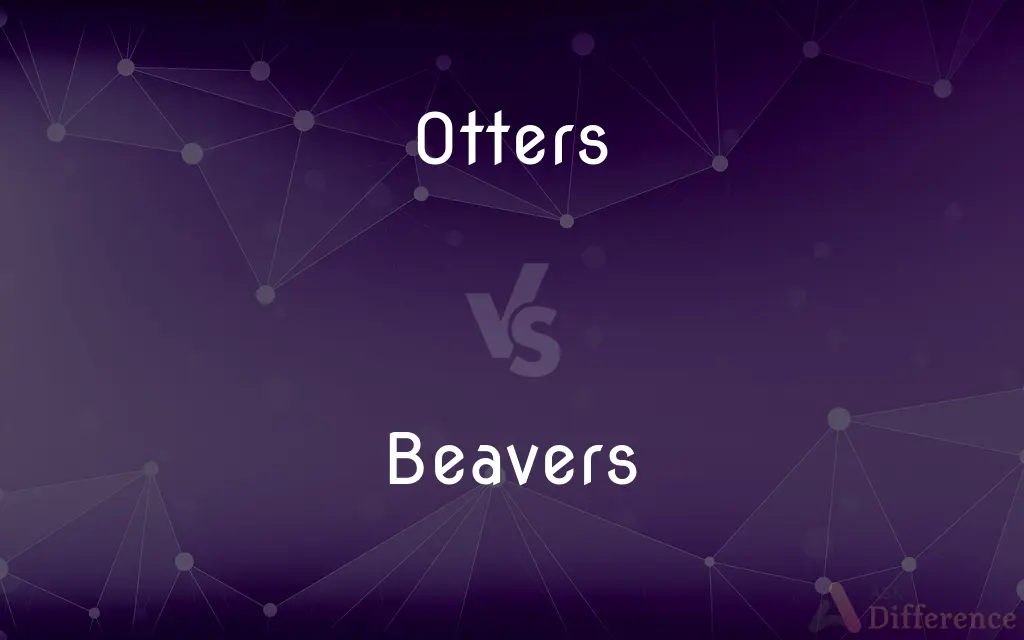Otters vs. Beavers — What's the Difference?
Edited by Tayyaba Rehman — By Fiza Rafique — Published on December 3, 2023
Otters are streamlined aquatic mammals known for their playful behavior, while beavers are robust, semi-aquatic rodents recognized for building dams. Both are adapted to life in and around water.

Difference Between Otters and Beavers
Table of Contents
ADVERTISEMENT
Key Differences
Otters, with their slender bodies and webbed feet, are agile swimmers. Beavers, on the other hand, are more stout, equipped with broad, flat tails that serve as rudders in water.
While otters frequent both freshwater and marine environments, relishing their time sliding on riverbanks or hunting fish, beavers predominantly inhabit freshwater habitats, meticulously constructing dams and lodges for protection.
Otters primarily feast on fish, crustaceans, and other small aquatic animals. Beavers, being herbivores, favor a diet of tree bark, aquatic plants, and twigs.
Otters, whether in groups called romps or as solitary animals, are renowned for their playful antics and social bonds. Beavers are more family-centric, often living in monogamous pairs with their offspring, collaboratively building and maintaining their structures.
Comparison Chart
Physical Traits
Slender, streamlined body
Stout body with a broad, flat tail
ADVERTISEMENT
Habitat
Freshwater and marine environments
Predominantly freshwater habitats
Diet
Fish, crustaceans, small aquatic animals
Tree bark, aquatic plants, twigs
Social Behavior
Playful, sociable in romps or solitary
Family-centric, monogamous pairs
Ecosystem Role
Control fish populations
Create wetlands, support diverse species
Compare with Definitions
Otters
Mammals known for playful behavior and agility.
Children were delighted watching otters slide on muddy banks.
Beavers
Large rodents with a distinct flat tail.
Beavers use their tails for navigation and communication.
Otters
Aquatic mammals adept at swimming and diving.
Otters often glide effortlessly through water in search of prey.
Beavers
Ecosystem engineers creating habitats for various species.
Beavers' dam-building activities result in rich wetland ecosystems.
Otters
Animals that can thrive in both freshwater and marine settings.
Some otters prefer coastal regions, while others inhabit rivers.
Beavers
Herbivores that consume bark and aquatic vegetation.
Beavers are often found stripping bark from fallen logs.
Otters
Creatures with dense fur for insulation in cold water.
Otters have specialized fur that keeps them warm and buoyant.
Beavers
Social animals living in family groups.
A pair of beavers and their offspring collaboratively maintain their habitat.
Otters
Predators with a diet consisting mainly of aquatic animals.
Otters can consume a significant amount of fish daily.
Beavers
Either of two large semiaquatic rodents, Castor canadensis of North America or C. fiber of Eurasia, having thick brown fur, webbed hind feet, a broad flat tail, and sharp incisors used for gnawing bark and felling trees, with which they construct dams and underwater lodges.
Otters
Any of various aquatic or semiaquatic carnivorous mammals of the mustelid subfamily Lutrinae, having webbed feet and dense, dark brown fur.
Beavers
The fur of a beaver.
Otters
The fur of one of these animals.
Beavers
A top hat originally made of the underfur of a beaver.
Otters
Plural of otter
Beavers
A napped wool fabric, similar to felt, used for outer garments.
Beavers
Vulgar Slang The female genitals.
Beavers
Offensive Slang A woman or girl.
Beavers
A piece of armor attached to a helmet or breastplate to protect the throat or lower face.
Beavers
The visor on a helmet.
Beavers
Of or relating to a beaver or beavers
Beaver fur.
A beaver hat.
Beavers
Constructed by beavers
Beaver dams.
Beavers
To work diligently and energetically.
Beavers
Plural of beaver
Beavers
Semi-aquatic rodents renowned for building dams.
Beavers can transform landscapes with their impressive architectural skills.
Common Curiosities
What do otters primarily eat?
Otters mainly consume fish, crustaceans, and small aquatic animals.
What are otters?
Otters are playful aquatic mammals known for their agility in water.
Where can otters be found?
Otters inhabit both freshwater and marine environments.
How do beavers differ from otters in appearance?
Beavers are stout with a broad, flat tail, while otters are more slender.
Are beavers carnivorous like otters?
No, beavers are herbivores, primarily eating tree bark and aquatic plants.
Why do beavers build dams?
Beavers construct dams for protection and to access food during winter.
Are otters and beavers endangered?
Some otter species are endangered, while beavers have faced threats but are currently widespread.
Are otters and beavers active during the day?
Both otters and beavers can be crepuscular, active during dawn and dusk, but this can vary by species and region.
Do otters and beavers hibernate?
Neither otters nor beavers hibernate, but they prepare for winter differently.
How do otters and beavers benefit the environment?
Otters help control fish populations, while beavers create wetlands benefiting diverse species.
Are otters social animals?
Yes, otters can be very sociable, often seen playing or hunting together.
How do beavers communicate?
Beavers use vocalizations and tail slaps on water for communication.
Which is larger, an otter or a beaver?
While size varies by species, some beavers can be larger than otters.
Do otters build structures like beavers?
No, otters don't build dams or lodges like beavers, but they may use dens.
How do otters and beavers adapt to cold water?
Both have dense fur and fat layers for insulation against cold water.
Share Your Discovery

Previous Comparison
Niagara Falls vs. Iguazu Falls
Next Comparison
Australia Flag vs. New Zealand FlagAuthor Spotlight
Written by
Fiza RafiqueFiza Rafique is a skilled content writer at AskDifference.com, where she meticulously refines and enhances written pieces. Drawing from her vast editorial expertise, Fiza ensures clarity, accuracy, and precision in every article. Passionate about language, she continually seeks to elevate the quality of content for readers worldwide.
Edited by
Tayyaba RehmanTayyaba Rehman is a distinguished writer, currently serving as a primary contributor to askdifference.com. As a researcher in semantics and etymology, Tayyaba's passion for the complexity of languages and their distinctions has found a perfect home on the platform. Tayyaba delves into the intricacies of language, distinguishing between commonly confused words and phrases, thereby providing clarity for readers worldwide.
















































